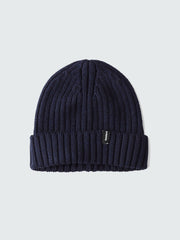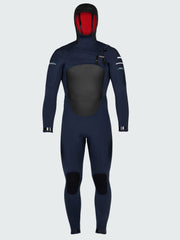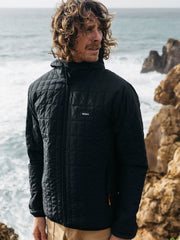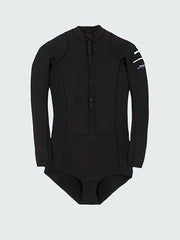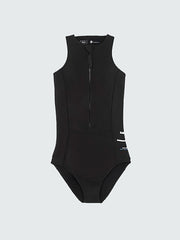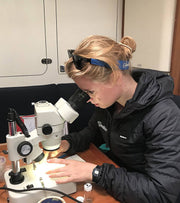The Problem With Microfibres
When Finisterre launched the Microplastics Collection back in 2018, there was limited science around the issue of microfibres. Since then, more research has been undertaken and fresh evidence shows that the problem isn't just limited to synthetic fibres as we previously thought.
As a producer of clothing, we’re constantly examining the impact of our garments, during their production, use and end of life. A plastic researcher and scientist at the University of Plymouth, Dr Imogen Napper looks at the latest information and what can be done to reduce the overall impact of microfibre pollution.
5 min read
Images courtesy of The Microfibre Consortium and eXXpedition Round the World.

When you think about plastic items, what comes to mind?
Perhaps a plastic bottle? A plastic carrier bag? Plastic food packaging?
Raising my hand, I never considered clothing. Yet, around 60% of textile fibres produced globally are synthetic, made from plastics like polyester, acrylic, and nylon. But clothing can also be made from semi-synthetic and man-made cellulosic textiles. Take a look at your own clothes, and you might be surprised. As I write this, I checked mine: my top is 100% cotton, but my trousers are 100% viscose (also known as rayon - a semi-synthetic textile material made from regenerated and purified plant material).
So, clothing can be made from synthetic, natural and man-made cellulosic textiles, and we're still understanding their impact on the environment.
Fibres from all these types of clothing can shed during their lifecycle, including when they're worn, washed, and tumble dried. These tiny fibres can end up in our water systems and eventually make their way to the ocean where they can harm wildlife and be mistaken for food by fish, and can ultimately enter our food chain.
Plastic fibres (less than 5 millimetres long) contribute to an estimated 9% of the world's ocean microplastic pollution. However, while there's a general consensus that natural and man-made cellulosic textiles have reduced environmental impact due to their potential quicker biodegradability, we still don't fully understand the risks they pose. Research has noted their environmental prevalence in several microplastic pollution studies, with natural textile fibres dominating freshwater and atmospheric fibre populations over plastic in Nottingham (UK).

Credit - Steven Lake

Credit - Steven Lake
Research over the last few years has continued to identify the extent of the issue:
1. Wearing clothes made of microplastics can release plastic fibres into the air. For example, clothing can shed 400 fibres per gram of fabric during just 20 minutes of normal activity, like walking.
2. A typical 6-kilogram laundry load or regular wearing of clothes can release over 6 million microfibers into the environment.
3. Plastic fibres have even been found at the top of Mount Everest, likely from climbers' clothing shedding them during their trek to summit the mountain.
4. Major rivers can release up to 1–3 billion microplastics every day, with microplastic concentration increasing from source to sea.
5. Various devices have been designed to capture or stop microfibres released from clothing during the washing cycle. Although there is a wide range in efficiency, some filters were found to be 78% effective.

Credit - Bonita Baker-Robins

Credit - Nomad Mneumonics
Finisterre's Stance
The scale of the problem means it’s an issue that can only be solved with collaboration across brands, industry partners and scientists. All parties need to work together, and in 2018 Finisterre became a founding member of The Microfibre Consortium – a collection of brands and manufacturers pushing for further research and practical solutions to be used within the textile industry. As a producer of clothing and with our passion to protect the natural world, we feel a huge responsibility to understand and reverse the impact of the microfibres problem.
As a brand Finisterre uses a balance of both natural fibres and synthetics, with our top textile use shared across organic cotton, recycled polyester and wool, and in 2023 we conducted testing of five fabrics across our core range to get a baseline of their impacts. Building on those results and informed by our findings, in 2024 we are focused on developing a strategy for future testing, supporting TMC to fill any potential gaps in the datasets that make up The Microfibre Data Portal.
"Brands that sign The Microfibre 2030 Commitment seek to make positive changes to their products in order to reduce fibre fragmentation at the root-cause, the fabric itself. Finisterre is amongst a growing community of pioneering organisations, each actively engaged in a number of research‑led activities to advance understanding of microfibre pollution from all textiles.” – Anna Bateman, Senior Stakeholder Ambassador, The Microfibre Consortium

TMC Process - The Microfibre Consortium

TMC Process - The Microfibre Consortium
What can you do to reduce your impact?
Wash less, wear more
Microfibres shed in the wash, so the less you wash your garments, the fewer microfibres you’re producing – as well as saving water. Products like outerwear, denim or wool knitwear really don’t need washing as often as you think, so try to only wash your gear when absolutely necessary.
Filter your fibres
There are a range of in-home filter options that have been developed to combat this issue. Using a washing bag or adding a filter to your machine can help trap macrofibres before they enter the water system and make their way to the ocean.
Love your gear for longer
Ultimately, the most sustainable product is the one you already own. By repairing and keeping your gear going for longer you’re reducing your consumption and lessening demand on the manufacturing end. That’s what our Lived & Loved repairs service is here for – breathing new life into old favourites and saving them from landfill.
Petition/ letter to MP
Add your voice to the campaign for change by writing to your MP and calling for legislation that will require manufacturers to fit microfibre filters in all new domestic and commercial washing machines as standard.
_
These are not solutions to the wider issue. But, as we wait for the science to show us the way forward, we’re committed to championing ways to reduce the impact of our products as much as possible.
The microfibres problem will not be resolved by a single brand or industry sector, nor is it the responsibility of the consumer. It is a complex and intertwined issue which is going to take true collaboration, a fresh approach and real innovation to solve. As we learn more we will continue to refine our range and manufacturing practices, sharing our journey with our community and empowering them with the knowledge to take action in their own lives.

































